Fantastic, June and July 1962: A Pair of Retro-Reviews
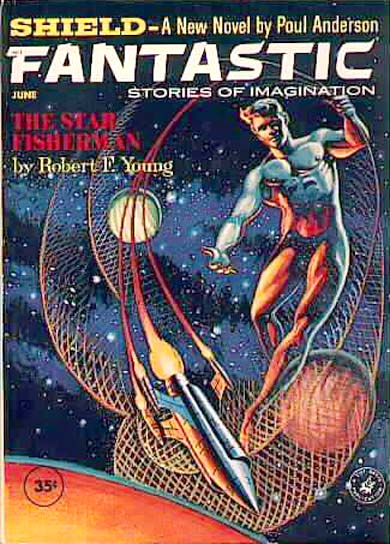 |
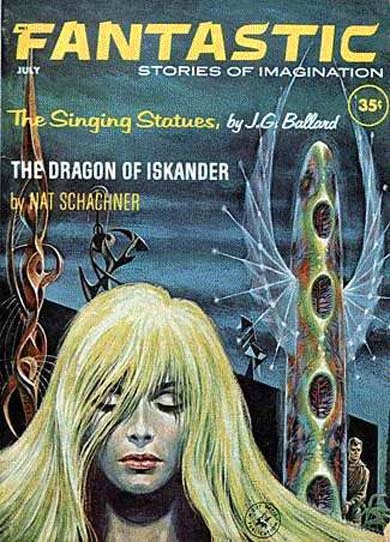 |
| Cover by George Barr | Cover by Emsh |
Another pair of Cele Goldsmith-edited issues of Fantastic, featuring a Poul Anderson serial. And an interesting letter on the subject of Mervyn Peake by Michael Moorcock.
The editorials, by Norman Lobsenz, consider a Russian project to increase silk production by selecting for male silkworms, and a theory that the physical constants may not be constant. The covers are by George Barr (quite good) and Ed Emshwiller (not his best). Interiors are by Leo Summers, Dan Adkins, Emshwiller, and George Schelling.
The letter column was quite irregular in Fantastic, but it’s present in the July issue, for something of a special occasion, perhaps. Michael Moorcock, then a very young writer (his first story, in collaboration with Barrington Bayley, appeared in New Worlds in 1959, and his first solo work in 1961 in Science Fantasy), had read comments about Mervyn Peake and his Gormenghast books in Fantastic earlier that year, and he wrote to mention that Peake (whom he knew well) was seriously ill and unlikely to write another Titus Groan book.
[Click the images for bigger versions.]
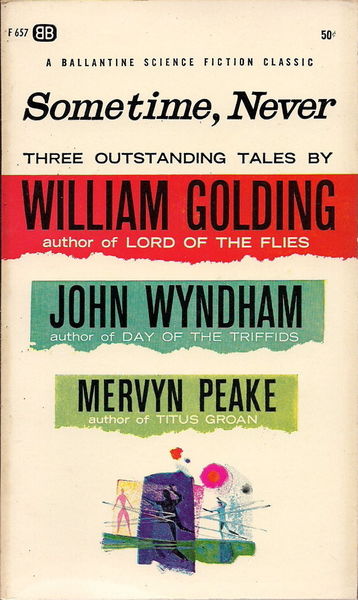 |
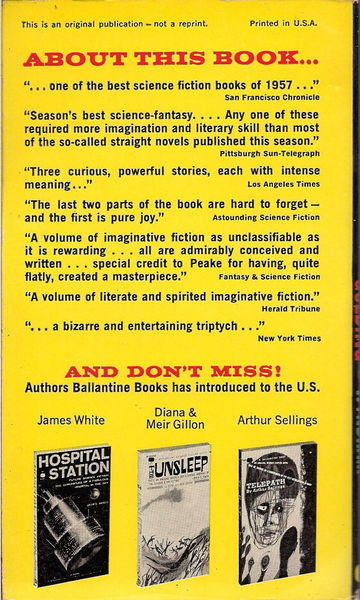 |
He commends the anthology Sometime, Never to the Fantastic readership (which included good stories by Peake, William Golding, and John Wyndham). He disputes reader Pat Scott’s contention that the Gormenghast books were “Gothic” (a common characterization), and instead suggests Peake’s writing, despite the grotesqueries and “purple prose,” is more objective — more like Shakespeare than Dylan Thomas. He compares Steerpike to Richard III. He laments the likelihood (which proved true) that Peake would write no more. He praises Fritz Leiber highly (much better, he suggests, than Dunsany). And he finds time to praise Fantastic in particular. A brief following letter from Sharon Towle gives directions on how to order Peake’s books from the UK — and also how to order Tolkien’s books! The other letters are from the above-mentioned Pat Scott (praising the Davidson/Moore serial Joyleg); Bill R. Wolfenbarger (from Neosho, MO!, and praising Leiber); and Bob Adolfsen, praising artists George Barr and Vernon Kramer.
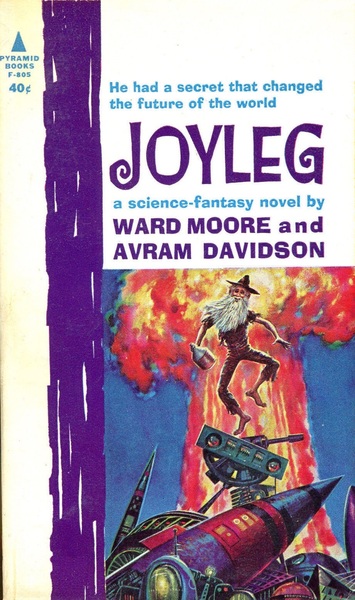 |
 |
Here are the stories:
June
Serial
Shield, part 1 of 2, by Poul Anderson (17,000 words)
Novelets
“The Star Fisherman,” by Robert F. Young (13,000 words)
“The Past Master,” by Robert Bloch (8,200 words)
Short Stories
“Ended,” by David R. Bunch (2,200 words)
“Rain, Rain, Go Away,” by James A. Cox (4,900 words)
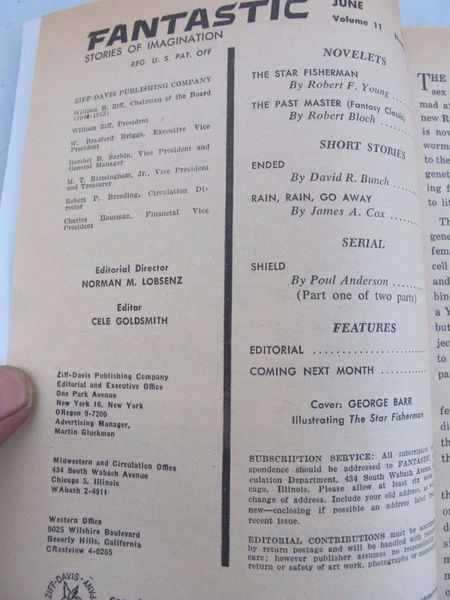 |
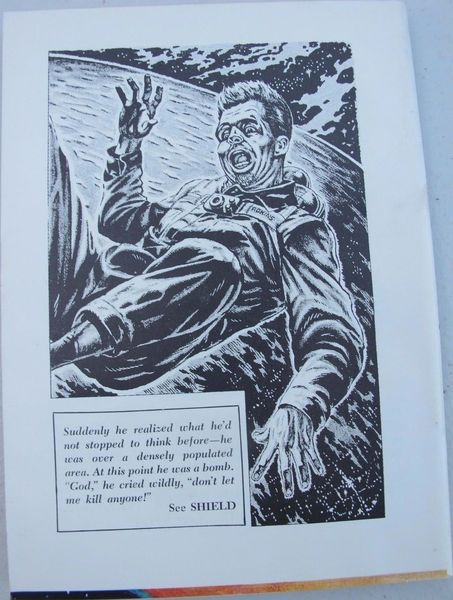 |
July
Serial
Shield, part 2 of 2, by Poul Anderson (12,500 words)
Novelet
“The Dragon of Iskander,” by Nat Schachner (12,000 words)
Short Stories
“The Singing Statues,” by J. G. Ballard (4,500 words)
“A Drink of Darkness,” by Robert F. Young (4,800 words)
“The Thinking Disease,” by Albert Teichner (3,500 words)
“One Long Ribbon,” by Florence Engel Randall (4,100 words)
Shield, obviously is a very short “novel” in this serialization. It was published in book form by Berkley in 1963 (below left). I have a copy of the 1970 reprint (below middle), also from Berkley. (Both editions have covers by Richard Powers, but different ones, and in fact the 1974 Berkley reissue, below right, has yet a third different Richard Powers cover.) That version is about 45,000 words long.
 |
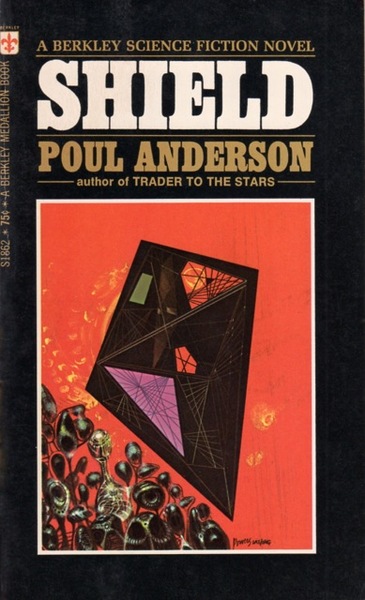 |
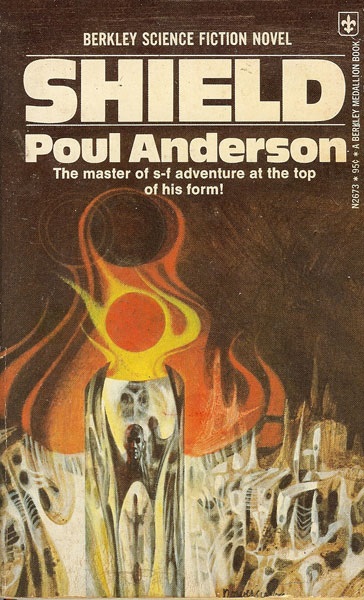 |
This is minor Anderson, but worthwhile reading. I remember liking it on first reading more than I did on this rereading — that’s either the result of several decades of additional experience on my part, or perhaps of the difference between the serial version and the book version.
The hero is Peter Koskinen, who has just returned from Mars, with the secret of a personal body shield, learned with the wise old Martian natives. He soon realizes that his secret is coveted by several entities: the Chinese, the rather despotic rulers of the US, and the mob, more or less. None of these organizations seem all that interested in Koskinen’s health, nor indeed in what’s best for the world. Koskinen falls in with a femme fatale named Vivienne, whose motives are difficult to untangle. All leads to a conclusion where Koskinen, under siege from multiple sources, must make a decision consistent with his own values.
 |
 |
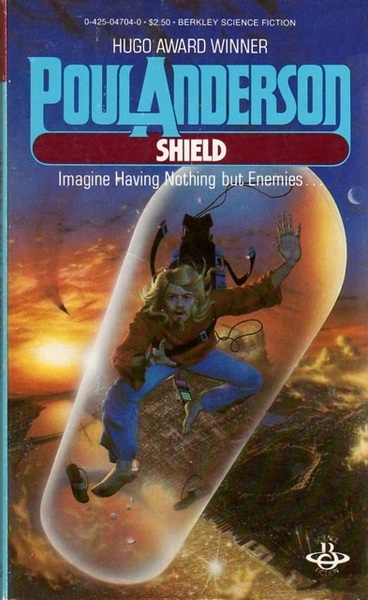 |
Two of the three novelets are reprints. June’s reprint, Robert Bloch’s “The Past Master” is introduced, curiously, with a blurb stating that Bloch’s Hollywood success (due to Psycho) made it economically unfeasible for the magazine to publish a new story by him. This story first appeared in Bluebook for January 1955, one of the last issues of that venerable magazine (it lasted until 1956). At least that presumably means he was paid for the reprint (reprints from Amazing and Fantastic did not require further payment, though it’s possible that during Ziff-Davis’ ownership a nominal fee was offered.) It’s an amusing mordant tale of a time traveler coming to our time with a strange mission — to buy up as much significant art as he can. It turns out (not surprisingly) that nuclear war will soon wipe out civilization, and the time traveler wants to preserve as much as he can to take back to the future, after humankind has recovered. There is, of course, a twist, nicely enough handled.
The July reprint is closer to Fantastic’s usual run of “Fantasy Classics.” It’s a worthwhile endeavor, really. The story, Nat Schachner’s “The Dragon of Iskander,” appeared in a non-SF magazine, Top-Notch, in 1934, so its reprint here very possibly was the first time most readers, even veteran readers, had seen the story. Schachner (1895-1955) was an interesting case — he began writing for the pulps in 1930 in collaboration with Arthur Leo Zagat, and he continued, often with Zagat but also solo, for about a decade, then stopped. He was noted as the first writer of a “Thought Variant” story for F. Orlin Tremaine at Astounding. (Tremaine also edited Top-Notch.)
And indeed this story is pretty interesting. Owen Crawford is leading an exploration of the remote corners of China. Against the desire of his fellow explorers, including the Chinese authorities, he continues into the Heavenly Mountains, despite the rumors of Dragons there. What he finds is unexpected: the Dragons are something like modern fighter planes, and this remote kingdom turns out to be ruled by descendants of Alexander the Great. Crawford finds himself caught between the intrigues of the Chinese and the desires of the King, and most especially his beautiful daughter … In the end the resolution is conventional enough, but the story is pretty good fun.
The one new novelette is from Robert F. Young, oft-discussed here, as he was a regular for Goldsmith’s magazine. “The Star Fisherman” is a story of obsessive love and time travel, subjects Young would address often. Christopher Stark is a wealthy but not quite accomplished man, who becomes a star fisherman, an occupation not much described that seems to involve harvesting something from interstellar space (such as the Alpha Centauri Archipelago!). One trip he “harvests” a dead body, an old man, with a picture of a much younger woman who must be his grand-daughter. In the manner of Robert F. Young’s heroes, he is immediately wildly in love with this woman (Priscilla Petrovna), and he rushes to Europa (her address is written on the back of the photo) to find her. The problem is, Europa is the most puritanical place in the Solar System. He finds her, but she expresses no interest. So he buys a hypno-camera, and hypnotizes her, and abducts her, and, yes, rapes her (implied, not shown). She still will not submit to marrying him, and he ends up abandoning her in a more licentious colony, and, a wanted man, flees. Some time later he returns, and learns that she has been sexually liberated by her time as a whore in the place where she was abandoned. But she truly loves him now, and has been waiting for her. Of course, he’s furious about the men she’s been with, so he kills her.
OK, now that’s all pretty disgusting, eh? And we’re supposed to take it as an inspiring love story, I think. Though that’s a bit unfair — it’s clear that Stark’s last act, murdering Priscilla, is wrong. (The hypnotism, the abduction, the rape — that’s all apparently excusable on account of his love. Ick.) Anyway, Stark is arrested, and sent to prison, and after he gets out the time travel aspect kicks in … there is a treatment he can take that will send him back in time, but he will only live a fraction of his whole span after that … so he goes back and finds Priscilla, and naturally it turns out HE was a lover that he had been jealous of, and it also turns out, after his aging process and another time jump — well, you can see it coming — he becomes the original “grandfather” that he had found, with the picture of Priscilla. There’s something clever if silly about this time manipulation (though he did something similar but better (without the rape) in “The Honeyearthers,” from Amazing in 1964), but it’s hard to overcome the icky sexual politics of the story (even though Stark is, in the long run, punished for his sins.) Also, the cavalier silliness of the science aspects, and the “worldbuilding,” such as it is, was pretty annoying.
David Bunch’s “Ended” is longer than most of Bunch’s stories, but otherwise wholly characteristic. If you like Bunch — and for my money he’s such an original he demands reading, even though he’s neither a comfortable read nor a consistently satisfying read — you’ll find this worthwhile. If not, not.
James Cox’s “Rain, Rain, Go Away” is one of only three stories he published in the SF magazine (two in Fantastic, one in Amazing, in 1957 and 1962). It’s a reasonably clever story, told by an inventor as he is interrogated by Congress. Apparently he invented a means of weather control, and was laughed at. So he set it up and started using it — eventually leading to its widespread adoption. With, in the long run, easy imaginable negative results.
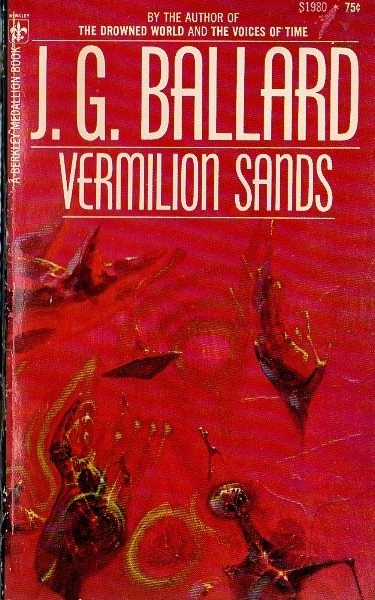 |
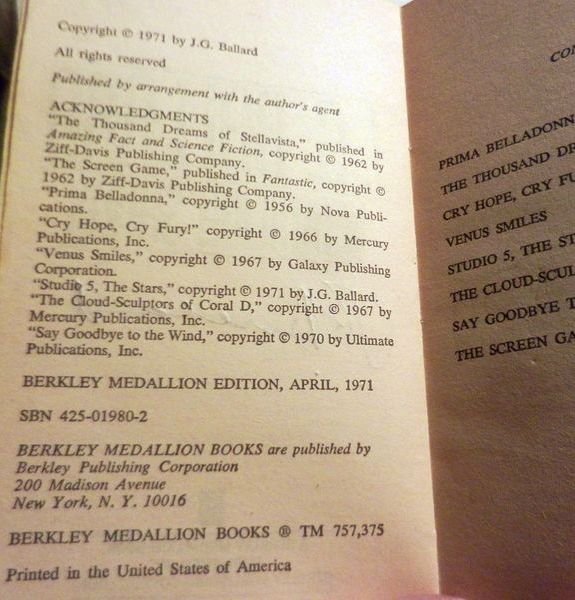 |
 |
 From July the leadoff story is J. G. Ballard’s “The Singing Statues,” one of his Vermilion Sands stories. 1962 was the year that Ballard was really introduced to American magazine readers, and Cele Goldsmith was the leader in publishing him, with four stories in Amazing that year and this one in Fantastic. To my mind it’s relatively minor Ballard, and one of the less interesting Vermilion Sands stories. A creator of sound statues is intrigued when a rich patron comes to his dealer’s gallery, and he creates a fake tape to make his latest work play the “Creole Love Song” — which somehow makes her buy it. There follows a period where the patron is obsessed with the sculpture — and the sculptor becomes slightly obsessed with her. But of course that can’t work, especially as the sculpture is not a true sonic sculpture. It is quite well-written, as we expect from Ballard, and the story is effective enough, but there is no real SFnal zing, nor even really a particularly Ballardian feel, except in the image in the last paragraph.
From July the leadoff story is J. G. Ballard’s “The Singing Statues,” one of his Vermilion Sands stories. 1962 was the year that Ballard was really introduced to American magazine readers, and Cele Goldsmith was the leader in publishing him, with four stories in Amazing that year and this one in Fantastic. To my mind it’s relatively minor Ballard, and one of the less interesting Vermilion Sands stories. A creator of sound statues is intrigued when a rich patron comes to his dealer’s gallery, and he creates a fake tape to make his latest work play the “Creole Love Song” — which somehow makes her buy it. There follows a period where the patron is obsessed with the sculpture — and the sculptor becomes slightly obsessed with her. But of course that can’t work, especially as the sculpture is not a true sonic sculpture. It is quite well-written, as we expect from Ballard, and the story is effective enough, but there is no real SFnal zing, nor even really a particularly Ballardian feel, except in the image in the last paragraph.
Robert F. Young’s “A Drink of Darkness” is about an alcoholic, regretting the way he ruined the lives of his wife and child… when he meets a strange man who gives him another chance, to go back and choose to stay away from the drink. But he warns him that he won’t remember any of this, so what will stop him making the same bad choices. The stinger to the story is kind of weird, somewhat disconnected: it’s the revelation of who the mysterious man who gives the hero his second chance is, and what his own terrible mistake was.
Albert Teichner contributes “The Thinking Disease.” Like many of his stories that I’ve seen, it has a neat enough central idea, though this is not his best. The hero learns to induce an out of body experience just in time for the robot revolt — so his mind survives while the robots kill him. He is able to work with a scientist to figure out how to stop the robots. It was a bit silly and convenient by the end, really.
Finally, the Little Known Writer for July is Florence Engel Randall. “One Long Ribbon” was her first story. She had one other story, also in Fantastic, “The Boundary Beyond” (July 1964); and a novel, A Watcher in the Woods, YA SF for Atheneum in 1976.
The story concerns a young widow who has been left a “perfect house” by her dead husband. But on moving in, she finds the house very unsatisfying. How could he have been so wrong… then a young man shows up, who is building a house nearby … soon we realize that that is the perfect house for her and her young son. Sentimental, of course, but not bad in its space.
Our recent coverage of Fantastic includes:
December 1959
April 1960
January 1962
February 1962
June and July 1962
November and December 1963
January and February 1964
August and September 1964
October 1964
January 1965
June 1965
Fantastic Stories: Tales of the Weird & Wondrous, edited by Martin H. Greenberg and Patrick L. Price
Rich Horton’s last Retro-Review for us was the November 1961 issues of Amazing Stories. His website is Strange at Ecbatan. See all of Rich’s retro-reviews here.
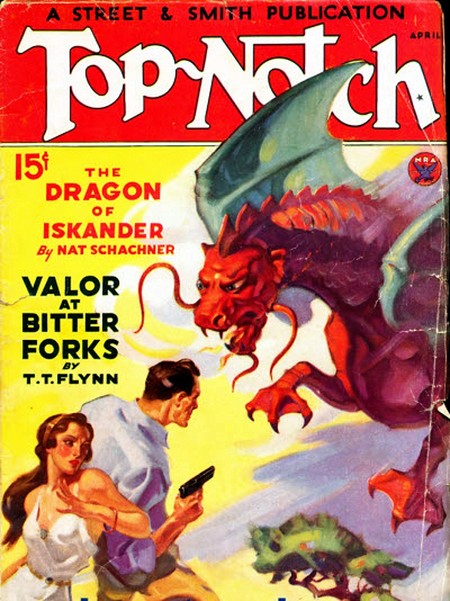
It was fun to read your retro-review of an issue I actually own — the one with the Moorcock letter about Mervyn Peake, which is why I’ve hung on to it through so many moves, etc. It’s pleasant to think of the same issue as boosting Peake and Tolkien.
I own the cover painting of Vermilion Sands (the one with funny dwarf or giant woman) by Peter Andrew Jones. My painting is slightly different than the book cover. Seems that the editors for the book made the woman’s bikini somewhat larger.
http://i.imgur.com/6ulp0OQ.jpg
Charles,
Wow! Thanks for sharing that. I love the bigger version. And I think your version is better. 🙂
Thanks Charles. It must be great to own original art like this!
Interesting review Rich. With eBay and the Internet one can easily forget how difficult it may have been to obtain books published in another country (addendum to Moorcock letter).
I do too, John. It should have been used as the cover without retouches.
The other cover of Vermilion Sands looks like another Richard Powers painting. I love his art even if it seems to have nothing to do with the books they are illustrating.
As the permissions page reprinted from the original Berkley edition of VERMILION SANDS shows, the story I review here, which I called a weak Vermilion Sands story, was not included in the original 1971 collection. (It did appear in the 1973 UK version from Jonathan Cape, and as far as I know in all later versions, including my copy from Carroll and Graf, and including the Panther copy was the bowdlerized cover. I certainly agree that the original Peter Andrew Jones painting that Charles has reprinted was better!)